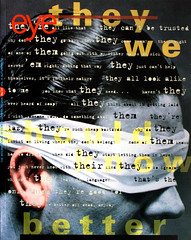Autumn 1994
Editorial Eye 14
Graphic design is so deeply inscribed within the fabric of everyday life that it is almost entirely taken for granted. Architecture benefits from regular analysis within the mainstream media. Three-dimensional design receives occasional column inches to the style pages. But moments when newspapers and television address graphic design are rare and, as a result, they usually lack conviction. A classic instance f this was BBC Design Awards. To readers outside Britain, the very idea that design should attract television coverage at all may sound enlightened. But the graphic design strand of the programme was in almost every sense a lost cause. Anyone without previous knowledge would have concluded on this evidence that graphic design was just another way of saying ‘advertising and packaging’. The finalists were a billboard campaign, a print campaign, a television commercial, packaging for a range of cleaning products, and a specially moulded CD container that was closer in industrial design than to graphics. Not a book, magazine, poster, postage stamp, corporate identity, signing system, multimedia project or example of information graphics was selected by the judges (who included Tibor Kalman) and, consequently, there was no chance to shed light on any of these areas. The relationship of design and advertising does of course shift all the time and it might have been interesting for the programme to have explored this as a sideline. Yet, as anyone working in either design or advertising could have told the BBC, they are two quite separate ‘industries’, with their own personnel, procedures, assumptions and audiences. Graphic designers expend a great deal of passion debating issues within the profession on their own terms. All too infrequent events such as BBC Design Awards offer an uncomfortable reminder of how most of this energy and thinking passes the world by. It is not just a question of persuading business that it needs graphic design – the usual preoccupation of design organisations. Graphic design has yet to locate itself on the wider map of culture as a subject as deserving of sustained critical attention as architecture, art, or for that matter, advertising.
Rick Poynor, Eye editor, London
First published in Eye no. 14 vol. 4 1994
Eye is the world’s most beautiful and collectable graphic design journal, published quarterly for professional designers, students and anyone interested in critical, informed writing about graphic design and visual culture. It is available from all good design bookshops and online at the Eye shop, where you can buy subscriptions and single issues.

